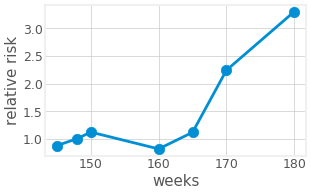Zero-Knowledge Risk Oracle for predictive diagnoses of childhood neuropsychiatric disorders from sparse electronic health records
Project description



- Info:
Zero-Knowledge Risk Oracle
- Author:
ZeD@UChicago <zed.uchicago.edu>
- Description:
Estimation of the risk of future diagnoses of neuropsychiatric disorders (particularly autism) in early childhood, based on the diagnostic codes recorded during doctor visits. The prediction pipeline is based on inferring optimal stochastic generators for diagnostic code sequences, and detecting subtle deviations that drive up risk of an eventual neuropsychiatric diagnoses. The out-of-sample AUC score on the Truven dataset of insurance claims (close to 3 million children in out-of-sample data) is just over 80%, for both males and females.
Usage:
from ehrzero import ehrzero as ehr
risks = ehr.predict_with_confidence(source_filepath,out_filepath,
separator=',',delimitor=' ',
n_first_weeks=[week1,week2,..,weekn])Installation
pip3 install ehrzero --user --upgradeEHR data format
Diagnostic data stored in text file, one line per patient as follows: patient id, gender and list of space-separated, comma-delineated diagnosis records, all separated by spaces. Each diagnosis record consists of the week since the start of observation, followed by comma and the ICD-9 code of the diagnosis.
Example of a diagnostic record for Lorax, male:
Lorax,M 5,277.03 10,611.79 18,057.8 58,157.8 78,057.8 108,057.8 128,057.8 148,057.8
<patient_id,gender> <week,code> <week,code> ...Risk Estimation Example As Python Script
With properly formatted patient diagnostic history, we use function predict_with_confidence and specify the data filepath and the weeks of age at which we want to estimate risk. Optionally, we may also specify the separator (separating code and week, see example above) and delimitor (separating two code-week pairs, see example above) for the diganostic records within file (space and comma are default).
The predict_with_confidence function returns the predicted risk of autism for each patient for each requested week.
from ehrzero import ehrzero as ehr
source = './src.dat'
outfile = './out.dat'
weeks = [100,200]
risks = ehr.predict_with_confidence(source,outfile,
separator=',',delimitor=' ',
n_first_weeks=weeks)Command Line Execution
A commandline tool zero.py is included in the package.
It is located in the <installation_directory>/ehrzero/example. Typically, the default installation_directory should be ~/.local/lib/python3.6/site-packages/
Invoking the tool with examples of diagnostic history included in the package may be done as follows (adjust for correct python version, and installation_directory):
cd ~/.local/lib/python3.6/site-packages/ehrzero/example
python zero.py -data tests/exD1.dx -n 145 148 150 160 165 170 180
A032532061 145 0.015349 0.883183 18.33
A032532061 148 0.017537 1.009113 98.61
A032532061 150 0.019578 1.126543 98.86
A032532061 160 0.014294 0.822491 19.68
A032532061 165 0.019506 1.122396 98.85
A032532061 170 0.039018 2.245151 99.74
A032532061 180 0.057424 3.304231 99.92
Project details
Release history Release notifications | RSS feed
Download files
Download the file for your platform. If you're not sure which to choose, learn more about installing packages.













